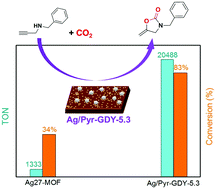Graphdiyne anchored ultrafine Ag nanoparticles for highly efficient and solvent-free catalysis of CO2 cycloaddition†
Abstract
Apart from photo-/electro-catalytic CO2 reduction, an important alternative route to CO2 utilization is to use this inert molecule as a C1 source to synthesize value-added chemicals; however, the practical application is limited by the low conversion efficiency. Herein, we reported a composite catalyst of 3D sponge-like pyrenyl-graphdiyne (Pyr-GDY) anchored ultrafine Ag nanoparticles (Ag/Pyr-GDY), with the average size of Ag NPs of only 1.6 nm. The porous 3D Pyr-GDY component can not only anchor and stabilize the capping agent free ultrafine Ag NPs by virtue of the strong affinity between alkynyl groups and Ag, but also enhance the local concentration of CO2 due to the porous nature of 3D Pyr-GDY. As a result, the optimized Ag/Pyr-GDY catalyst displays a record-high activity towards the catalysis of CO2 cycloaddition with propargylamines under ambient temperature and pressure, with a TON of 20 488 and a yield of 83%, and is 15.3 times more active than the most efficient catalyst Ag27-MOF (TON = 1333, yield = 34%). Moreover, our catalysis was performed in a solvent-free system, which provides an economic, green and practical avenue for carbon capture, utilization and storage (CCUS).

- This article is part of the themed collection: Graphyne


 Please wait while we load your content...
Please wait while we load your content...